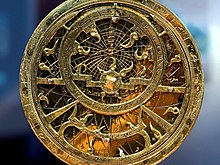ยุคทองของอิสลาม


ยุคทองของอิสลาม (อาหรับ: العصر الذهبي للإسلام) เป็นยุครุ่งเรืองทางวัฒนธรรม เศรษฐกิจ และวิทยาศาสตร์ในประวัติศาสตร์อิสลาม ตามธรรมเนียมถือว่าเริ่มตั้งแต่คริสต์ศตวรรษที่ 8 จนถึงคริสต์ศตวรรษที่ 14[1][2][3] และเป็นที่เข้าใจกันว่าเริ่มขึ้นในรัชสมัยของเคาะลีฟะฮ์ฮารูน อัรเราะชีด (ค.ศ. 786–809) แห่งราชวงศ์อับบาซียะฮ์ ด้วยการเปิดบัยตุลฮิกมะฮ์ในแบกแดด เมืองที่ใหญ่ที่สุดในโลกในขณะนั้น ที่นั่น นักวิชาการอิสลามและผู้รู้รอบด้านจากทั่วสารทิศซึ่งมีภูมิหลังทางวัฒนธรรมที่แตกต่างกันได้รับคำสั่งให้รวบรวมและแปลความรู้สมัยคลาสสิกของโลกเป็นภาษาซีรีแอกและภาษาอาหรับ[4]
ตามธรรมเนียมถือกันว่ายุคทองของอิสลามสิ้นสุดลงพร้อมกับการล่มสลายของรัฐเคาะลีฟะฮ์อับบาซียะฮ์เนื่องจากการโจมตีของชาวมองโกลและการล้อมแบกแดดใน ค.ศ. 1258[5] นักวิชาการจำนวนหนึ่งกำหนดจุดสิ้นสุดของยุคทองไว้ในราว ค.ศ. 1350 โดยเชื่อมกับสมัยฟื้นฟูศิลปวิทยาของตีมูร์[6][7] ในขณะที่นักประวัติศาสตร์และนักวิชาการสมัยใหม่จำนวนมากกำหนดจุดสิ้นสุดของยุคทองไว้ในปลายคริสต์ศตวรรษที่ 15 ต่อคริสต์ศตวรรษที่ 16 โดยเชื่อมกับสมัยดินปืนอิสลาม[1][2][3] (สมัยกลางของอิสลามอยู่ในช่วงคาบเกี่ยวกับยุคทองของอิสลาม โดยแหล่งข้อมูลหนึ่งกำหนดระยะเวลาไว้ระหว่าง ค.ศ. 900–1300)[8]
อ้างอิง
[แก้]- ↑ 1.0 1.1 George Saliba (1994), A History of Arabic Astronomy: Planetary Theories During the Golden Age of Islam, pp. 245, 250, 256–57. New York University Press, ISBN 0-8147-8023-7.
- ↑ 2.0 2.1 King, David A. (1983). "The Astronomy of the Mamluks". Isis. 74 (4): 531–55. doi:10.1086/353360. S2CID 144315162.
- ↑ 3.0 3.1 Hassan, Ahmad Y (1996). "Factors Behind the Decline of Islamic Science After the Sixteenth Century". ใน Sharifah Shifa Al-Attas (บ.ก.). Islam and the Challenge of Modernity, Proceedings of the Inaugural Symposium on Islam and the Challenge of Modernity: Historical and Contemporary Contexts, Kuala Lumpur, August 1–5, 1994. International Institute of Islamic Thought and Civilization (ISTAC). pp. 351–99. คลังข้อมูลเก่าเก็บจากแหล่งเดิมเมื่อ 2 April 2015.
- ↑ Gutas, Dimitri 1998. Greek Thought, Arabic Culture: The Graeco-Arabic Translation Movement in Baghdad and Early 'Abbāsid Society (2nd-4th/8th-10th Centuries). London: Routledge.
- ↑ Islamic Radicalism and Multicultural Politics. Taylor & Francis. 2011-03-01. p. 9. ISBN 978-1-136-95960-8. สืบค้นเมื่อ 26 August 2012.
- ↑ "Science and technology in Medieval Islam" (PDF). History of Science Museum. สืบค้นเมื่อ 31 October 2019.
- ↑ Ruggiero, Guido (15 April 2008). A Companion to the Worlds of the Renaissance, Guido Ruggiero. ISBN 9780470751619. คลังข้อมูลเก่าเก็บจากแหล่งเดิมเมื่อ 8 November 2016. สืบค้นเมื่อ 7 November 2016.
- ↑ Barlow, Glenna. "Arts of the Islamic World: the Medieval Period". Khan Academy. สืบค้นเมื่อ 31 October 2019.
อ่านเพิ่ม
[แก้]- George Makdisi "Scholasticism and Humanism in Classical Islam and the Christian West". Journal of the American Oriental Society 109, no.2 (1982)
- Josef W. Meri (2005). Medieval Islamic Civilization: An Encyclopedia. Routledge. ISBN 0-415-96690-6. p. 1088.
- Tamara Sonn: Islam: A Brief History. Wiley 2011, ISBN 978-1-4443-5898-8, pp. 39–79 (online copy, p. 39, ที่กูเกิล หนังสือ)
- Maurice Lombard: The Golden Age of Islam. American Elsevier 1975
- George Nicholas Atiyeh; John Richard Hayes (1992). The Genius of Arab Civilization. New York University Press. ISBN 0-8147-3485-5, 978-0-8147-3485-8. p. 306.
- Falagas, M. E.; Zarkadoulia, Effie A.; Samonis, George (1 August 2006). "Arab science in the golden age (750–1258 C.E.) and today". The FASEB Journal. 20 (10): 1581–86. doi:10.1096/fj.06-0803ufm. PMID 16873881. S2CID 40960150.
- Starr, S. Frederick (2015). Lost Enlightenment: Central Asia's Golden Age from the Arab Conquest to Tamerlane. Princeton University. ISBN 978-0-691-16585-1.
- Allsen, Thomas T. (2004). Culture and Conquest in Mongol Eurasia. Cambridge University Press. ISBN 978-0-521-60270-9.
- Dario Fernandez-Morera (2015) The Myth of the Andalusian Paradise. Muslims, Christians, and Jews under Islamic Rule in Medieval Spain. ISI Books ISBN 978-1-61017-095-6 (hardback)
- Joel Epstein (2019) The Language of the Heart Juwal Publications ISBN 978-1070100906
แหล่งข้อมูลอื่น
[แก้]- Islamicweb.com: History of the Golden Age
- Khamush.com: Baghdad: Metropolis of the Abbasid Caliphate – Chapter 5 เก็บถาวร 2020-09-20 ที่ เวย์แบ็กแมชชีน, by Gaston Wiet.
- U.S. Library of Congress.gov: The Kirkor Minassian Collection – contains examples of Islamic book bindings.
Text is available under the CC BY-SA 4.0 license; additional terms may apply.
Images, videos and audio are available under their respective licenses.
